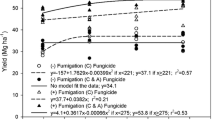Abstract
The application of nematicides resulted in increased potato yields, and populations ofPratylenchus penetrans were lower for 3 years after application; but longevity of benefits of fumigating potato fields varied with the kind and amount of nematicide, application methods and with growing conditions after fumigation. Fumigation of two fields in the fall of 1965 with Vorlex, Telone, D-D, and mixtures of chloropicrin with Telone or D-D resulted in 70% to 90% control of the meadow nematode,P. penetrans, after two crops in one field, and 50% to 70% control after three crops in another. Yield increases of Kennebec potatoes averaged 42% and 16% in successive crops in the first field and yield increases of Katahdin potatoes averaged 13%, 22% and 16% in three successive crops in the other field. Fumigation resulted in 30 to 70% less vascular browning in tubers in the first two crops but there was no effect in the third crop. There was no effect on black scurf in any crop. Root injury varied proportionally with populations ofP. penetrans in roots in 1967. Populations ofP. penetrans regained injurious levels in three other fields after one crop when abundant root growth in moist 1967 followed spring fumigation with Telone and D-D. Under poor conditions for sealing of the soil following fumigation in the spring of 1968, counts ofP. penetrans collected at different soil depths after fumigation showed excellent kill below 3 inches and poorer kill in the upper 2 inches of soil.
Resumen
La aplicación de nematicidas dió mayores rendimientos de papas y las populaciones dePratylenchus penetrans permanecieron más bajas durante 3 años después de la aplicación; sinembargo la duración de los efectos de la fumigación de los campos de papa variaron con el tipo y cantidad de nematicida, métodos de aplicación ye con las condiciones del crecimiento después de la fumigación. La fumigación de dos campos en otoño de 1965 con Vorlex, Telone, D-D, y mezclas de cloropicrina con Telone o D-D dieron 70% a 90% control del nematodo de pradera,P. penetrans, después de dos cosechas en un campo y 50% a 70% control del nematodo después de tres cosechas en otro. Incrementos de rendimiento de papas Kennebec promediaron 42% y 16% en cosechas cosechas sucesivas en el primer campo y los incrementos en rendimiento de papas Katahdin promediaron 13%, 22% y 16% en tres cosechas sucesivas en el otro. La fumigación dió 30 a 70% menos pardeo vascular en tubérculos en las dos primeras cosechas pero no tuvo efecto alguno en la tercera cosecha. En ninguna de las cosechas hubo efecto alguno sobre la tiña negra. El daño a las raíces varió en proporción a las populaciones deP. penetrans en las raíces durante 1967. Populaciones deP. penetrans recobraron niveles dañinos en otros tres campos después de una cosecha cuando se produjo un abundante crecimiento de raíces en suélo húmedo después de la fumigación con Telone y D-D durante le primavera. Cuando el suelo no se compactó después de la fumigación en la primavera de 1968 recuentos deP. penetrans colectados a diferentes profundidades del suelo después de la fumigación indicaron una destrucción excelente de la plaga en niveles debajo de tres pulgadas y una destrucción menos efectiva en las dos pulgadas del suelo.
Similar content being viewed by others
Literature Cited
Green, R. J. 1964. Control of Verticilium wilt of peppermint by soil fumigation. Pl. Dis. Reptr. 48: 960–963.
Kunkel, R. and M. Weller. 1965. Fumigation of potato soil in Washington. Amer. Potato J. 42: 57–59.
McKeen, C. D. and Mountain, W. B. 1960. Synergism betweenPratylenchus penetrans (Cobb) andVerticillium albo-atrum. R & B. in eggplant wilt. Can. J. Botany 38: 789–794.
Miller, P. M. 1957. A method for the quick separation of nematodes from soil samples. Plant Dis. Reptr. 41: 194.
Miller, P. M. and L. V. Edgington. 1962. Controlling parasitic nematodes and soil borne diseases of potatoes with soil fumigation. Amer. Potato J. 39: 235–240.
Miller, P. M., L. V. Edgington and Arthur Hawkins. 1967. Effects of soil fumigation on Verticillium wilt, nematodes and other diseases of potato roots and tubers. Amer. Pot. J. 44: 316–323.
Miller, P. M. and Arthur Hawkins. 1967. Effects of fall fumigation on nematodes, early maturity disease, yields, and vascular discoloration of tubers of Kennebec and Katahdin potatoes. Amer. Potato J. 44: 339.
Rich, Saul and P. M. Miller. 1962. Effect of soil fungi and antifungal fungi on the incidence of strawberry root disease. Phytopathology 52: 296.
Wilson, J. D. 1968. Soil fumigation. Amer. Potato J. 45: 414–426.
Author information
Authors and Affiliations
Rights and permissions
About this article
Cite this article
Miller, P.M., Hawkins, A. Long term effects of preplant fumigation of potato fields. American Potato Journal 46, 387–397 (1969). https://doi.org/10.1007/BF02869559
Accepted:
Issue Date:
DOI: https://doi.org/10.1007/BF02869559



